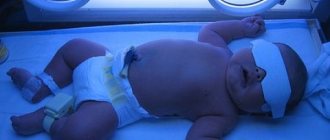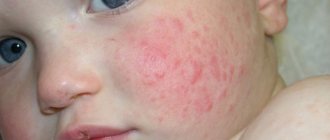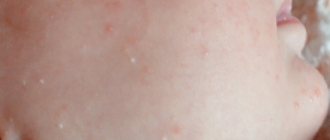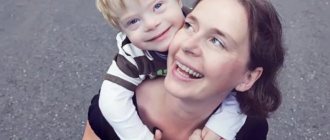The central and autonomic nervous systems are formed at the early intratubal stage of fetal development. They continue to develop throughout pregnancy. The evolution and adaptation of a baby’s nervous activity takes place up to 3-4 years. Therefore, the syndrome of movement disorders may be a consequence of pathologies that arise at different stages of the formation of the fetus or newborn baby.
The syndrome of movement disorders in children can manifest itself in the early neonatal period in the form of a lack of important reflexes. Also, pathology may begin to appear closer to the age of 5-6 months. Parents may notice the baby's lethargy and apathy, initially mistaking it for a characteristic of the child's character. In fact, any apathy on the part of the baby and his lack of keen interest in the environment indicates dysfunction of higher nervous activity.
Motor dysfunction is divided into spinal and cerebral types. In the first case, damage to the nerve fiber responsible for organizing motor activity occurs at the level of the spinal column. This may be a complication of labor, malpresentation of the fetus, hemangioma, incorrect position of the vertebral bodies, etc.
The cerebral type of pathology may be associated with hypertonicity due to malfunction of the cerebral cortex. If this structure develops incorrectly, it cannot efficiently process signals coming from the peripheral nervous system. As a result, it is impossible to perform movements in full. Mild paresis and paralysis may occur; the most dangerous complication is cerebral palsy (CP).
It is very important to recognize motor dysfunction syndrome in a child in the early stages. Pathology associated with the innervation of muscle tissue that does not develop and does not work properly is always excluded.
In early infancy, clinical signs may be an increase or decrease in muscle tone (up to complete paralysis or flaccid paresis), absence of reflexes or their excessive manifestation, the appearance of pathological mobility or stiffness. If their symptoms are moderate, a course of therapeutic massage and gymnastics can help. If you seek medical help in a timely manner, you can avoid the development of cerebral palsy in its expanded form.
This article describes the mechanism of development of pathology, distinctive clinical signs, types of disorders and methods of their correction without the use of potent pharmacological drugs.
If your baby is showing signs of motor dysfunction, don't waste time waiting for it to go away on its own. Until the cause of the developing disorders is discovered and eliminated, the disease will progress. Even in a month it may already be too late.
In Moscow, you can make a free appointment with a neurologist at our manual therapy clinic. All patients receive a free consultation. The doctor conducts an examination, establishes a preliminary diagnosis and gives individual recommendations for additional examination and treatment.
Causes of movement disorder syndrome
Movement disorder syndrome in children under one year of age can be caused by abnormal development of the fetus during the intrauterine stage. This could be hypoxia, umbilical cord entanglement, malpresentation, etc. Only a neurologist can determine the true cause of the syndrome of impaired motor activity. You should not try to diagnose yourself at home, much less treat.
When conducting a differential diagnosis, the doctor first determines the type of disorder: hypotension or hypertonicity of myocytes is observed. Then the area of damage to the nerve fiber and the presumed cause of this disorder are determined. And only after this can effective and safe treatment be started.
Muscle hypotonia is characterized by the absence of resistance during forced movement of the arms and legs. If you lay the baby on his back and try to bend his arms and legs, spread them apart and bring them back, you may feel resistance. This is the effect of the peripheral nervous system, which does not have time to process the signal coming from myocytes. With serious damage to the spinal cord and central nervous system, the child may become like a “rag doll.”
Movement disorder syndrome can develop in children for the following reasons:
- hypoxia suffered during the prenatal period of development;
- cerebral hypoxia that develops during labor, for example, when the umbilical cord is entangled;
- asphyxia of a child with amniotic fluid due to violation of the technique of providing obstetric obstetric care;
- damage to myocytes and their insufficient development against the background of inferiority of the capillary bloodstream;
- disruption of nerve connections due to pathology of the development of the structure of the central and peripheral nervous system;
- traumatic effects in the spine, head;
- incorrect position of the first cervical vertebra and its displacement;
- assimilation of the first cervical vertebra by the occipital bone;
- compression of individual large branches of the peripheral nervous system (femoral, sciatic, elbow, brachial, radial);
- hereditary genetic developmental disorders;
- improper metabolism and much more.
It is not uncommon for movement disorder syndrome to be present in children who are not treated with rickets prophylaxis. With vitamin D deficiency, pathological deformations begin in the structures of bone, tendon and muscle tissue. Which can subsequently lead to the appearance of decreased or increased muscle tone.
Muscular hypertension in children
The syndrome of hypertension of individual elements or entire muscle groups will be characterized by the opposite phenomena than with hypotension. This is an increased resistance to passive movements, in addition, due to this, a limitation of the voluntary or spontaneous motor activity of infants . Also typical is an increase in tendon reflexes with an expansion of the zone of occurrence, pathological settings of the arms and feet (twisted, pinched). Typically, increased muscle tone can predominate in the area of flexor muscle groups, as well as those holding the posture; the muscles in the hips and shoulders can be significantly changed, which is expressed in the child adopting a certain typical posture. But a diagnosis is not made based solely on posture and muscle hypertension is not immediately determined - these are additional and relative criteria for pathologies.
note
Additional criteria will be changes in congenital reflexes and special symptoms of Gordon, Babinski or Oppenheim reflex. Under normal conditions, they are mild, have an inconsistent occurrence and, as the child develops, weaken and fade away. Against the background of increased muscle tone, they are constantly observed, and have no dynamics of extinction.
In terms of severity, muscle hypertonia syndrome can have variations from a slight increase and increased resistance for passive movements of the baby to complete immobility and stiffness (this is called decerebrate rigidity - the complete impossibility of voluntary and other movements, the muscles are so toned).
In such serious cases, even the use of medications that have the properties of muscle relaxants (relax the muscles) cannot lead to muscle relaxation, and it is even more impossible to carry out passive movements with the hands of parents or a doctor.
If the hypertension syndrome has a mild manifestation, is not combined with the presence of pathological (also known as tonic) reflexes, or is not complicated by other neurological disorders, it will not significantly affect development . This usually manifests itself in inhibition of the development of motor abilities in children in the first months (up to one year old) - they later roll over, then begin to crawl, etc. Based on the location, in which muscle groups the tone is greater, the development of certain skills and motor acts will be inhibited.
For example, if there is excess muscle tone in the arm area, there may be a delay in the development of directional movements of the arms toward objects, difficulty grasping toys, or manipulating objects. Grasping skills in the hands may be particularly affected. In parallel with the fact that babies later begin to grab things and toys for manipulation, they retain a specific (ulnar) grip for a long time - they take objects with the whole hand. But tweezer grips with fingers can develop slowly, in some cases requiring special training and additional stimulation. The development of the formation of protective functions of the hand may be inhibited; in these situations, the reactions of maintaining balance while lying on the stomach, when learning to sit and stand, as well as when walking will be inhibited accordingly.
If the muscle tone of the legs suffers, support reactions on the part of the legs and the skills of sitting down independently may be inhibited, then such children with difficulty and reluctance stand on their legs, preferring crawling, and stand on their tiptoes with support from a support.
We recommend reading: What is dangerous and how to recognize muscle hypertonicity in infants
Types of movement disorder syndromes
The division into types of movement disorder syndrome is carried out according to whether muscle tone is decreased or increased. There is hypotonicity, hypertonicity and a mixed type, in which some muscles may be in a tense state, while others at this time may not be able to perform movements at all. The latter is the most severe form of the disease.
Pathology is also divided according to stages of development:
- The initial symptom complex is characterized by a slight increase or decrease in muscle tone. Only a doctor can recognize the characteristic signs (children often have seizures, they do not show interest in the bright things around them);
- the second stage is a developed symptom complex, which becomes obvious even to parents who do not have special medical education (a child at the age of 1 year cannot hold his head up independently; when trying to sit, stand or crawl, he falls in unnatural positions);
- the late period occurs at the age of 2.5 - 3 years (the child cannot sit or walk independently, a secondary delay in psychomotor development occurs).
At the first stage, it is possible to completely cure the child without retaining residual signs of disorders. At the second stage, treatment can provide a noticeable improvement in the condition, but isolated flaccid paresis and paralysis may persist. The third (late) stage of the disease is distinguished by the fact that skeletal deformation and delayed psycho-emotional development are irreversible phenomena. Such a child can only be partially adapted to the social environment. In this case, it is no longer possible to completely eliminate the consequences of movement disorders.
Cerebellar disorders: role in movement disorders of children
The human cerebellum is an important brain center; it is responsible for coordination of movements and statics, as well as the smoothness and combination of motor acts, and maintaining posture. Cerebellar lesions in children from early childhood can be the result of intrauterine underdevelopment (cerebellar agenesis - underdevelopment, hypoplasia - decrease in volume), and it can also be affected as a result of birth trauma or acute asphyxia during childbirth. Sometimes a special option may be hereditary problems in its development or early degeneration, tissue death soon after birth.
Such problems lead to decreased muscle tone, problems with coordination of movements in the arms, as well as balance disorders, when children gradually master age-appropriate skills - they learn to sit and stand, then walk. In addition, cerebellar syndromes are typically characterized by the appearance of trembling in the arms and legs, problems with coordination and instability of gait; these can be identified after children have mastered voluntary and active movements.
Important
Parents may first begin to suspect problems in coordination if they observe their children and how they reach for toys, can grab them with their hands and pull them to their mouths, and also how they stand or sit, and then walk.
Infants who have problems with the cerebellum and coordination may make a lot of unnecessary movements when trying to grasp and hold toys, this is especially pronounced when babies are in a sitting position . They develop independent sitting with a pronounced delay, about 10-12 months; often during this period, children have difficulty maintaining balance and immediately fall when they need to turn to the sides or when they need to take objects. The child is afraid of falling, and therefore he does not play with objects with two hands, only with one, holding himself and maintaining support using the second hand. Children begin to walk closer to two years of age, but they often fall, and some of the babies, because of this, prefer crawling at a time when it is high time for them to walk normally.
In some cases, against the background of cerebellar disorders, floating eye movements and speech disorders , the first symptoms of dysarthria of cerebellar origin, may be observed in the first year of life. If the lesion is combined with damage to the cranial nerves, there may be specific delays in development - late fixation of the gaze on objects, tracking them, then problems with motor-visual coordination and impaired orientation in space; as they grow, significant problems with the development of speech arise and especially active.
Symptoms of movement disorders in infants
With careful attention to the child, the syndrome of motor disorders in infants can be noticed at about the age of 4 - 5 months. Children at this age are already beginning to hold their heads tightly and reach for toys and bright objects. If the baby does not show such skills, then you need to contact a neurologist as soon as possible.
You need to pay attention to the following symptoms of movement disorder syndrome:
- movements become slow, as if “soft”, not sharp;
- there is a constant decrease in muscle strength in the arms and legs;
- signs of muscle depletion appear (legs and arms become thinner);
- tendon reflexes can either increase or decrease;
- in severe cases, paresis and paralysis develop;
- at the slightest psycho-emotional or muscle tension, a convulsive syndrome may develop;
- if you observe a child, you will notice the presence of various movements that may be unnatural, chaotic, meaningless;
- grasping and sucking reflexes are impaired;
- the child is unable to bend his knees, hold his head, or raise his arms;
- the process of turning from stomach to back and back is disrupted;
- crying becomes monotonous and unemotional;
- the child rarely smiles and practically does not express emotions;
- the skin may be pale with a bluish tint.
Clinically, movement disorder syndrome in infants can produce a variety of symptoms, but the most basic are those described above.
Diagnosis of the disease
Even if there are obvious signs of a problem, you should not make a diagnosis yourself, much less self-medicate. It is necessary to contact a neurologist who will conduct a full examination and, based on its results, will be able to determine the presence of the disease and its type.
During diagnosis, the perinatal history is first taken into account. The doctor needs to know whether the child has had previous infections, toxic-metabolic disorders, or signs of hypoxia. Special attention is paid to assessing the condition of a newborn baby using the Apgar scale.
If there is a baby being examined whose fontanelle has not yet become overgrown, he is prescribed a Doppler study of cerebral blood flow and neurosonography. In particularly severe cases, a CT or MRI of the brain may be needed.
Additionally, the child’s skills are compared with developmental standards for his age. Neurologists and pediatricians in this case use special tables.
Consequences of movement disorder syndrome
The syndrome of impaired motor functions in the early stages can be corrected and the baby does not have any pathological signs of trouble. In advanced cases, the consequences of movement disorder syndrome are more serious. Oligophrenia and other disorders of psycho-emotional development may develop. Various deformations of the skeletal part of the musculoskeletal system occur. When large muscles are damaged, the ability to care for oneself, sit, and walk is impaired. The speech function in such children is not developed.
Parents need to begin treatment for movement disorder syndrome as early as possible.
Treatment methods for babies
In many ways, the difficulty of treatment is determined by the fact how early the problems are identified and how complex and severe they are, whether there are organic brain lesions of an irreversible nature. Today, neurologists have many effective techniques that can eliminate movement disorders in the early period and quite quickly and effectively. After full-fledged medical and additional treatment, functional disorders disappear without a trace, and with organic disorders in unadvanced stages, the situation can be significantly improved. Naturally, all recommendations are individual, but in general principles, treatment consists of:
- Courses of therapeutic general massage performed only by a specialist experienced in regulating muscle tone in infants
- A course of physical therapy and a special motor regimen, constant classes with the child
- The use of physiotherapy with various types of influences
- The use of groups of drugs that improve the transmission of nerve impulses and their perception by muscle fibers
- Drugs that normalize muscle responses to incoming impulses from the nervous system
- Vitamin preparations of the neurotrophic series (group B)
- Rehabilitation activities, classes at home with parents using special techniques.
In the presence of mild variants of SDN in children, everything can be quickly corrected, but serious organic pathologies cannot be completely corrected and will then require constant monitoring and rehabilitation courses throughout life.
Alena Paretskaya, pediatrician, medical columnist
46, total, today
( 47 votes, average: 4.49 out of 5)
Types of radiculitis and home treatment methods
How to get rid of tinnitus: causes and treatments for tinnitus
Related Posts
Impaired motor and psychomotor functions: therapy
Therapy for disorders of motor and psychomotor functions is divided into two types: physiotherapy and drug treatment.
If preventive diagnostics have shown a propensity for drug treatment, then use:
- Central paresis: hopantenic acid (125 milligrams per day, divided into two doses);
- Static paresis from the age of 12 months: – baclofen (from 0.5 to 1 milligram per kilogram of weight per day), mydocalm (5 milligrams per kilogram per day);
- Static paresis from two years of age: botulinum therapy;
- Inhibition of psychomotor development: hopatenic acid (125 milligrams per day, divided into two doses), pyritinol (10 milligrams per kilogram every day).
If the diagnosis reveals rigidity or spasticity, then thermal procedures must be performed.
Recovery period: what parents need to know and be able to do
Rehabilitation measures need to be studied by parents and practiced daily with the child. The main types of classes are exercises on a large gymnastic ball, various health-improving styling, and preparation for massage. In the future, with positive dynamics, exercises on the ball and laying should be combined with massages, physiotherapy, stimulation of visual and auditory analyzers.
During this period, speech therapy diagnostics of the glossopharyngeal muscles is necessary. During the rehabilitation period, it is also necessary to include classes on speech development. Currently, the most popular physiotherapeutic methods are the Voight technique, Bobath therapy, kinesitherapy, and induced limb movement therapy.
Let's look at the latter in more detail. Therapy for evoked movements of the upper and lower extremities is based on daily, six-hour reproduction of movements in the limbs of patients. This course lasts 21 days. To this is added professional massage, physical therapy, and laser therapy.
During the recovery period, one should not miss the formation of knowledge and self-care skills, cultural and hygienic skills in older children. It is necessary to create conditions under which children with cerebral palsy master these abilities. Parents should get away from overprotection; this will help the patient become more independent and develop more actively. It is necessary to pay attention to the fact that the level of requirements of the teacher corresponded to the level of requirements of the patient’s parents; this will not allow the patient to feel double standards of upbringing.
Developing self-care skills is one of the most important tasks of recovery. You need to solve many problems on a variety of topics: count the number of buttons, look at their color, shape, touch them, describe similar objects, etc.
Perinatal damage to the nervous system in newborns PCNSL
Perinatal damage to the central nervous system is a pathology that includes a group of different conditions that, under the influence of negative factors, adversely affect the spinal cord or brain of the newborn.
To date, there is no clear terminology describing PPCNSL in newborns. Until the 1990s, they used the classification proposed by Yu. Ya. Yakunin, where terms were used that were not entirely appropriate from the point of view of modern medicine.
Thus, the term “perinatal encephalopathy” (literally meaning “brain weakness”) indicated persistent, almost irreversible changes in the nervous system. But many perinatal disorders are reversible. At the initial stage of life, the brain has enormous compensatory capabilities and is able to fully recover even with pathology of moderate severity.
And the term “cerebrovascular accident” was associated by neurologists with strokes and did not have clear signs. Over time, it began to be called “cerebral ischemia.” A separate conversation about hypertensive-hydrocephalic syndrome. Intracranial hypertension is often diagnosed, while measuring cerebrospinal fluid pressure is quite difficult, and the diagnosis is often made on the basis of symptoms that are quite common for infants in the first weeks of life: chin trembling, increased excitability, shuddering, shallow sleep, restlessness and crying. As a result, children unjustifiably take serious drugs from an early age.
However, perinatal lesions exist and cannot be ignored. Severe pathology is really dangerous for the baby’s life. According to some estimates, the diagnosis of PPCNSL is made in 5 to 55% of newborns. This difference is explained by the inclusion here of mild forms of disorders in this period. This is mainly a problem for premature babies, since body weight at birth directly affects the formation and functioning of the nervous system.
The diagnosis is relevant only for babies in the first year of life (that is why it is called “perinatal”; the word indicates the time close to birth). When the baby reaches 12 months, a different diagnosis is made, based on the totality of existing symptoms.
Treatment
- Relaxing massage. One of the most effective methods of therapy, but not if the parents themselves get down to business. Dear fathers and mothers, try to understand: your concern for the health of your own child is understandable, but any treatment must first of all be effective. You can, of course, crush your baby’s legs or arms yourself, but it’s better to trust the professionals. Try to understand that massage (like the East) is a really delicate matter, and SDN is not a diagnosis that forgives a frivolous attitude towards oneself. The recommended course duration is 15 sessions.
- Therapeutic physical education (physical therapy). This should also be dealt with by a specialist, but in this case a lot depends on the parents themselves. Exercise therapy is considered a slightly less effective method of therapy than the already mentioned massage, although it should not be neglected. Especially considering that the treatment of SDN must be comprehensive.
- Physiotherapeutic procedures (phonophoresis, electrophoresis, ultraviolet irradiation) can help in a speedy recovery, but, alas, one cannot count on much. Especially considering the age of the young patient. On the other hand, if your baby’s medical record includes a diagnosis of “motor disorder syndrome,” why not try all possible methods of therapy?
- Drug treatment. Despite its obvious effectiveness, it is used relatively rarely. Many parents deliberately refuse medications prescribed by a doctor, preferring not to overload the baby’s body with chemicals, and not without reason. After all, most domestic doctors are distrustful of alternative methods of treatment that do not bring immediate recovery, and prefer to “smother” any disease with pharmaceutical tablets.
- Homeopathic and folk remedies. At this point, the positions of doctors and parents of young patients again diverge. Various herbal infusions and tinctures are always popular among the people, but most fathers and mothers forget that even the most “harmless” recipe is by no means a panacea for all occasions.
Symptoms
Before moving directly to the manifestations of SDN, it is worth noting that none of them can be called unique. In other words, such “symptoms” can be observed even in absolutely healthy children, so there is no need to “panic” and run to the doctor after every sneeze. On the other hand, stubbornly ignoring progressive developmental delays can lead to the most tragic results (and massage alone is unlikely to help the patient). Therefore, in this matter it is necessary to show special flexibility, trying not to go to extremes. The symptoms of SDN themselves may be as follows:
- monotonous crying for no apparent reason;
- slow visual and auditory reactions to external stimuli;
- the baby picks up toys (often it takes him several attempts to do this), but does not understand well what to do with them next. In children with various developmental disorders (note, we are not talking about SDN) this happens quite often;
- limited facial activity;
- obvious expression of emotions may be delayed (the first smile at 3-4 months is not that uncommon);
- incorrect articulation, due to which children experience late activation of speech zones (parents may hear the expected “ma”, “pa”, “ba” and “da” not at 6-8 months, but much later);
- labored breathing.
The opinion that fathers and mothers should closely monitor the baby and communicate more often with “colleagues” on specialized forums deserves special mention. It’s stupid to argue with the first part of this statement, but we would advise you to refrain from overly active discussion with the parents of other children. The adequacy of some regular visitors to children's forums is highly questionable, so do not be surprised if, for example, you are advised to treat a minor disorder or cold with heavy doses of antibiotics.
Stages of psychomotor development of children
- thalamopallidal (from birth to 4 months);
- striopallidal (up to 10 months): gradual decrease in muscle tone, increase in the number of targeted movements;
- the period of manifestation of higher cortical functions, the development of speech and complex conditioned reflexes.
Phases of development of children's motor skills
- SDA: spontaneous motor activity (from the first days of life to 8-9 weeks);
- monokinetic (2-5 months): independent control of limb movements;
- dromokinetic (5-12 months): the baby’s motor behavior becomes conscious, and any movements receive a specific goal (reach out to a toy, take this or that object);
- cratikinetic (from 12 months): final normalization of muscle tone, transition to “adult” motor skills, significant improvement in coordination of movements.
How the disease develops
We recommend reading: Consequences of cerebral ischemia in newborns
There are three phases (periods) of perinatal damage:
- acute - from birth or from the prenatal period to the 1st month of life;
- restorative; it is divided into early (2-3 months) and late (4-12 months, in premature infants up to 24 months);
- outcome of the disease.
Each interval has its own clinical picture and manifests itself in the form of certain syndromes. The severity of the disease is determined by how pronounced they are. Let's consider their features.
Acute period
- Hypertensive-hydrocephalic syndrome. Cerebrospinal fluid accumulates in the ventricles of the brain due to disruption of its outflow, thereby increasing intracranial pressure. Parents or doctors may notice a rapid increase in head circumference, as well as protrusion of the fontanel. Frequent regurgitation, more like vomiting, eye nystagmus, and poor shallow sleep indirectly indicate the development of hydrocephalus.
- Convulsive syndrome. Rarely occurs in the form of twitching of the arms, legs and head, and occasional shuddering.
- Vegetative-visceral syndrome. It manifests itself as a marbled skin tone (as the tone of peripheral vessels is impaired), problems with the gastrointestinal tract and the cardiovascular system.
- Apathy syndrome. The vital reflexes of sucking and swallowing are weakened, and motor activity is reduced along with decreased muscle tone.
- Increased neuro-reflex excitability. Characterized by muscular dystonia: tone can be either increased or decreased; reflexes fade longer than usual, children's chin trembles, especially when crying, which occurs every now and then for no apparent reason. The baby sleeps superficially. The syndrome accompanies a mild degree of severity of the disease.
- Comatose syndrome. It occurs as a result of severe depression of the central nervous system and indicates the difficult situation of the newborn. An infant who has fallen into a coma is placed in intensive care in an unconscious state, since there are no signs of coordinating brain activity.
Muscle weakness is a warning sign
Recovery period
The early recovery period is deceptive, because it seems that neurological disorders become less pronounced, muscle tone returns to normal, and reflexes are restored. But over time, the clinical picture worsens again. It should be noted that such a situation arises only when moderate and severe CNS damage has been diagnosed in newborns.
It is quite logical that a child who has suffered this pathology will develop with a delay. He will be able to hold his head up, sit and walk later than his peers. Later, the first smile and interest in the world around you will appear. All delays in motor and mental development should prompt parents to once again show their baby to a neurologist, although children with such a diagnosis are already registered with him.
Also, if intensive drug therapy is used during the acute period, then in the recovery phase the emphasis is on physiotherapy, massage courses, and psychocorrection.
Outcome of the disease
The results of the therapy are reported closer to the age of one year. With a favorable prognosis, the following consequences may persist:
- delayed development of speech skills, motor and mental state;
- hyperactivity and attention deficit - the child cannot concentrate on the subject being studied for a long time, has difficulty remembering new things, and is inclined to show aggression and impulsiveness;
- cerebroasthenic syndrome (expressed in feelings of anxiety, shallow sleep, manifestations of hysteria, weather dependence).
Severe disease leads to the development of:
- epilepsy;
- cerebral palsy;
- hydrocephalus.
Cerebral palsy is a consequence of severe damage to the central nervous system
In numbers, the options for the development of the outcome of the disease can be expressed as follows: 30% - complete recovery, 40% - functional disorders, about 30% are organic disorders, and in rare cases, death occurs.
Motor dysfunctions in an infant: necessary knowledge when choosing a clinic
For many parents, such diagnoses cut the ground from under their feet. Choosing a clinic, choosing a doctor, choosing a country where to conduct treatment - these are questions that every family must answer as soon as possible.
Increasingly, parents are choosing to undergo treatment abroad. The modern market is now oversaturated with clinics that provide medical tourism services. But the choice must be taken with full responsibility.
Factors to consider when choosing a treatment location:
- Duration of existence of the company in the market of medical services and tourism;
- Availability of documentation for the relevant work;
- Customer reviews.
Experts from the Mednavi medical tourism agency will help you decide on the country, clinic, and doctors; will help you collect the necessary documents and permits; will provide legal support. Call us +7 (495) 023-10-24. Mednavi cooperates with the world's largest clinics and centers. Confidently take a step towards solving your problem, and soon you will see your baby take his first steps.
Why is hypotension dangerous and what is its effect on infant development?
Naturally, impaired muscle fiber tone can significantly affect the child’s health and disrupt its full development, especially when it comes to hypotension.
note
If a decrease in muscle tone is detected in a mild form and is not combined with any other neurological pathologies, such a condition either does not in any way affect the growth and physiological development of the baby, or leads to inhibition and delay in the timing of the child’s psychomotor development, usually starting from the second half of the year, at this time motor acts and the most important skills should be especially actively formed.
Moreover, it is typical that the developmental lag occurs unevenly; quite complex motor acts and functions can be inhibited, which may require simultaneous and coordinated interaction of various muscle groups for their implementation. An example is the fact that a child of about nine months with the presence of muscle hypotonia, if he is seated by a doctor or parents, can sit, but he cannot sit down independently, coordinating his body.
There are options for muscle hypotension:
- localized in the area of one limb, occurring as a traumatic effect (paresis of an arm or leg). In such cases, the delay in skill development will be limited to the affected area and its effect on the rest of the child's body.
- widespread, with a clearly defined presence of severe muscle hypotonia. This fact can have a severe and significant impact on the motor development of children. For example, the development of motor acts in a pathology such as spinal amyotrophy (also known as Hoffmann-Werdnig syndrome) in a ten-month-old child corresponds to the level of a three-month-old child.
Delays in the development of motor functions, naturally, can also become the cause of peculiarities in the formation and development of the child’s mental functions. It is important to understand that when there is no possibility of voluntarily grasping objects with hands, this leads to inadequate formation of hand-eye coordination and various manipulations with objects and toys.
Often the formation of muscle hypotension is combined with various other neurological disorders in the form of cranial nerve paresis, the development of hydrocephalus or convulsive syndrome, all of this, in combination with aggravating circumstances, affects the delay of normal development and is determined not only by reduced muscle tone, but also by all other influences.
At the same time, it is worth noting that the localization and severity of reduced muscle tone, its effect on the inhibition of physical as well as mental development will largely depend on the disease that led to such phenomena. In the presence of convulsive syndrome, against the background of congenital dementia (or early acquired form), not only hypotension, but also a delay in mental development leads to pronounced delays in mastering the required movements.
Impaired motor reflexes associated with cerebellar dysfunction
Underdevelopment of the cerebellum, birth trauma, asphyxia, hereditary degeneration - all this leads to cerebellar disorders of the motor reflex.
Impaired cerebellar motor reflexes: clinical manifestations:
- Muscle tone is reduced;
- The balance reaction when sitting, standing, walking is impaired;
- Poor hand coordination when moving.
You can recognize such disorders yourself: such a child makes a lot of unnecessary movements when grasping an object, this is especially typical in a sitting position. Children with cerebellar disorders sit up late, learn to walk after a year, but often fall.











